Podcast: Play in new window | Download
Subscribe: Apple Podcasts | Spotify | Email | TuneIn | RSS
“All that lives must die, passing through nature to eternity.” William Shakespeare, Hamlet
If you enjoy walking in cemeteries, exploring graveyards, and discovering the artistic bone structures of ossuaries, then you’ll love this interview with Loren Rhoads. We discuss our mutual love of these places where nature often reigns in peace and beauty, and share our favorite places in Europe and North America.
Loren Rhoads is the author of 199 Cemeteries to See Before You Die, and Wish You Were Here: Adventures in Cemetery Travel, as well as paranormal romance novels, short stories, and essays.
Show notes
- Memento mori. We are life-obsessed, not death-obsessed!
- Why we both love cemeteries and graveyards and some of our favorite places to visit
- Graves that change the landscape
- The difference in burial rituals and death culture between Europe and North America
- Is there something more than just physical remains in a graveyard?
- Recommended books on cemeteries and graveyards
You can find Loren Rhoads at cemeterytravel.com and LorenRhoads.com
Transcript of the interview
Jo: Loren Rhoads is the author of 199 Cemeteries to See Before You Die, and Wish You Were Here: Adventures in Cemetery Travel, as well as paranormal romance novels, short stories and essays. Welcome, Loren.
Loren: Thank you so much for having me.
Jo: I’m so excited to talk to you. I love your work and your blog is so fascinating and you share so much.
First up, tell us a bit more about you and how you became so interested in cemeteries.
Loren: It was kind of by accident. I grew up in a little farming town in Michigan. And down the road from the farm was this cemetery where my family was buried. So, one year when my mom couldn’t figure out how to entertain us over the summer, she took us down there and taught us how to do gravestone rubbings.
It was the first time I’d seen my grandfather’s grave. And I have a cousin that was born about the same time as me but died as an infant. I’d never really thought about death before that. I knew my grandfather was gone, but I hadn’t thought about gone where really. So, that was my first introduction to cemeteries.
Years later, when my husband and I were going to Europe for the first time, a friend said, ‘You have to go to Père Lachaise.’ And I thought, ‘Jeez, how weird is that we’re going to make a trip to a cemetery.’ But we were there in January, so we pretty much had the place to ourselves. And I was just stunned by the little family tombs and all the amazing sculpture, and famous people buried there. At that point, somebody’s gone through the graveyard and chalked ‘Jim’ and an arrow all over the cemetery on all the tombs and if you followed the arrows they led you to Jim Morrison’s grave.
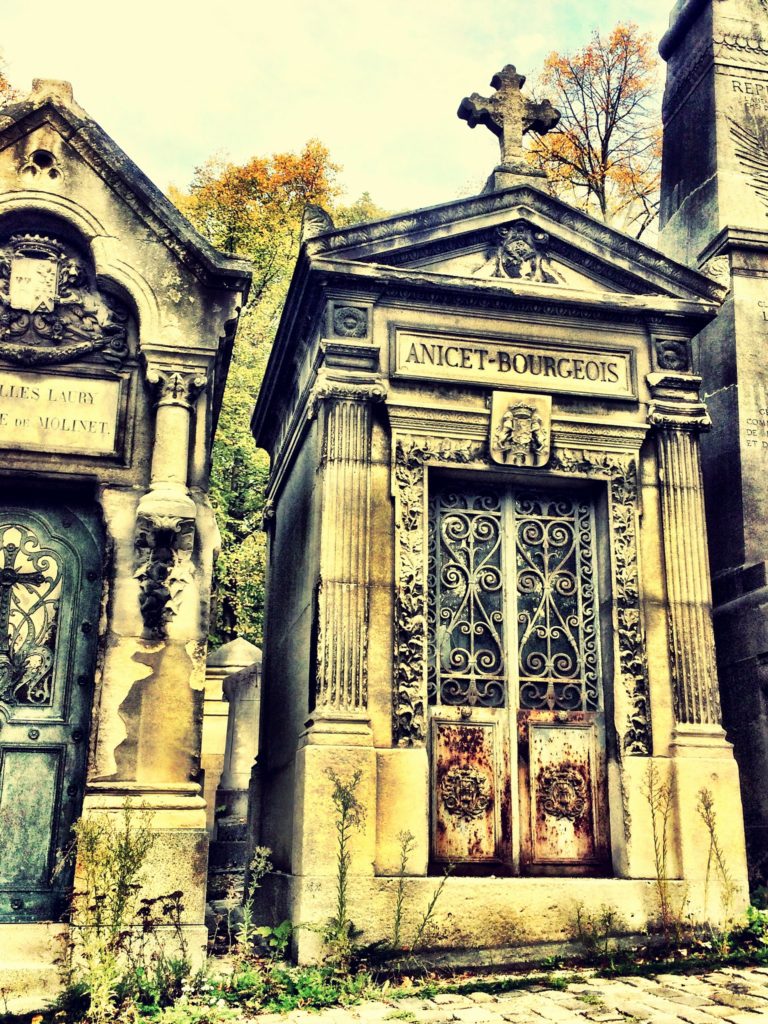
That was my first introduction to the cult of celebrity, I guess that people actually travel to cemeteries to see famous people. But it wasn’t the famous people that struck me, it was the beauty of the place when I got there.
Jo: I agree. And I love Père Lachaise, is gorgeous, it’s in Paris if people don’t know. And, as you say, there are lots of famous people, but all my pictures are of the sort of crumbling tombs, and none of them are the famous stuff.
Loren: Well, I came home with a phone full of photographs and there won’t be a single picture of me or my husband, but there’ll be 300 gravesites. A little obsessive.
Jo: Was that where you got the bug?
Loren: Actually, I got the bug in Highgate, where we had not intended to go to London at all, we were on our way to Spain. And this was as the first Gulf War was starting. We missed connection after connection trying to get across the ocean. And while we were flying to England to pick up another connection, the U.S. started to bomb Baghdad.
We decided, well, maybe we got to stay in a country where we speak the language and can understand what’s going on, watch the news, that sort of thing. And while we were there, we were in Victoria Station there was a little bookstore and I wandered in and picked up this book of just these luminous cemetery photos.
That was a Victorian Valhalla cemetery book about Highgate Cemetery. And Mason said, my husband, said, ‘We should go, we’d rather go see that, then go to the Tower of London.’ So, that’s what we did the last day of our trip. And Highgate was a Victorian cemetery founded jeez, like, I want to say, in the 1870s.
And it’s a high ground so it looks down over the city, it was very popular for people to come and picnic. But as time went on, and after World War I and the ‘flu pandemic and World War II, there were fewer and fewer families to take care of their graves and the cemetery began to lose money and eventually fell into disrepair and was locked.
It was taken over by a friends group, it was one of the first friend’s groups to rescue a cemetery and they still, all these decades later, still take care of it. But when we were there in the 1980s, it was still pretty rundown. One side of it at that point was closed unless you went on a tour and the other side was fairly wild.
Again, since it was January, we were the only people in the place, but you’d turn a corner and there’d be an angel. And she’d be completely overgrown with ivy except maybe her face was sticking out or one arm pointing toward heaven. It was so amazingly beautiful. And I thought, ‘Jeez, I just got to see this.’ Everywhere we go. I have to look for sculptures and angels specifically.
Jo: I went to Highgate probably I want to say maybe seven, eight years ago now, and we went in the high summer. And it was so green, like the color of the deep green because there’s a lot of trees and overgrowth, as you say, a lot of the graves are overgrown and nature is clawing it back all the time because it’s pretty big.
The side I’m thinking of, you obviously know it, the side with all the bigger graves, the older graves, it was so green. All my photos have this green tinge as if nature just was there with the dead.
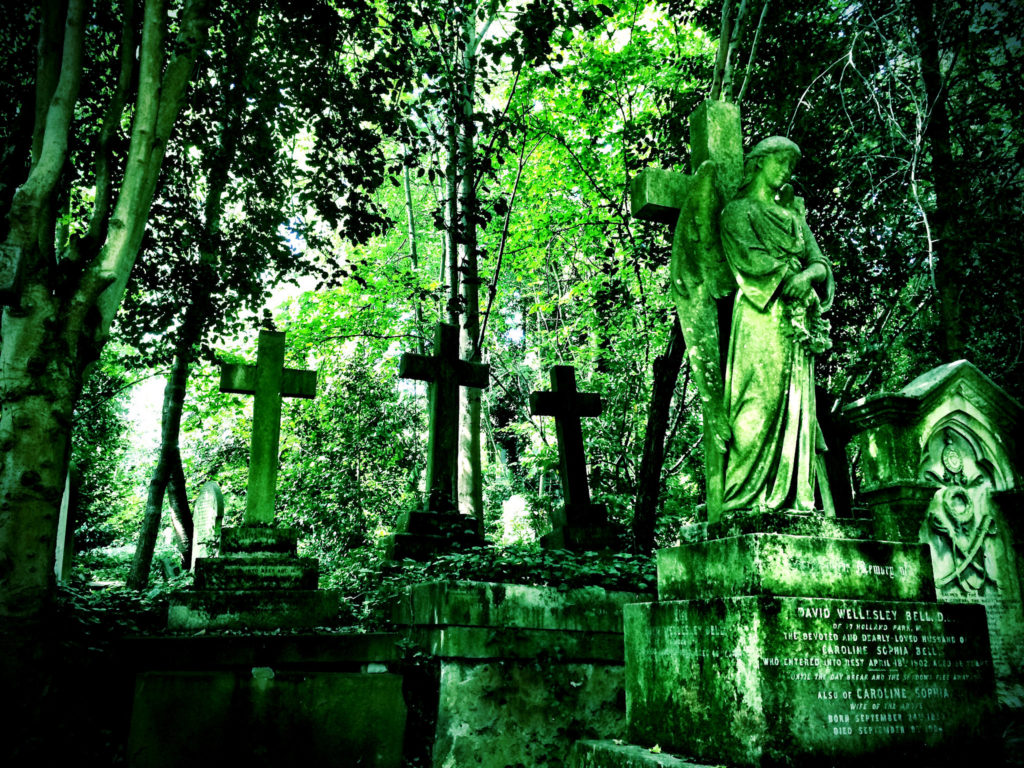
Loren: Isn’t that amazing? We went I think it was four years ago now in high summer, and it was a day when a thunderstorm was rolling in. And so, the light was kind of this odd orange color. But it made the green of all those trees just an amazing palette of green. So much more vivid. It’s a lovely place.
Jo: Maybe it’s because it’s highlighted against the stone that it makes that color stronger in our memory and in our photos. But it’s interesting that you had the same experience.
So, circling back, we’ll come back to some fun graves in a minute but it’s funny, I looked on your Instagram just
before we on and you’re putting together a logo for your Morbid Loren business, which I love. And I love the fact that you’re claiming this word ‘morbid’ because I feel like people say this to me. ‘Oh, you’re so morbid, or why do you think about death? And why do you go visit graveyards? Why do you like associating with death on your holidays?’ When people ask you that, what do you say?
Loren: I don’t think it’s morbid at all.
Every now and then somebody will accuse me of being death-obsessed. And for me, it’s the opposite, I am life obsessed.
I know we’ve just got a certain number of days. So, why wouldn’t you spend it out in the sunshine listening to birdsong and looking at beautiful art? What have you got to do with your life that’s better than that? I just don’t see cemeteries as morbid at all. I think it’s beautiful that we remember people.
There are all these amazing stories in the cemetery that you can learn, with the tour guide is the best way, but even just walking around and looking at the stones and reading the lovely old names and trying to make guesses about the iconography and their days of birth and death. It’s a way of connecting with the past that looking at architecture doesn’t do for me. Does that make sense?
Jo: Definitely. And I think the memento mori of going to a graveyard, “Remember, you will die at some point,” as you say, life obsessed because this is inevitable. We’re recording this during the pandemic of 2020. And it feels like perhaps people are getting a bit of a wake-up call around the fact that death is inevitable.
Loren: I hope so.
Jo: Therefore it is important to concentrate on how much you can make of your life.
Loren: Exactly. Don’t let a day pass. Because you have a gift to bring to the world. Why wait for the time, the perfect time when you’ve got hours to sit and concentrate? Isn’t that what we’ve all been wishing for, is time to sit down and read all those books we’ve been saving and write that novel? This is it. This is your moment, let’s do it now.
Jo: And in fact, you mentioned us sitting down. I often sit down in cemeteries and write. There are often, obviously, benches where you can sit and contemplate. And I feel like often in cities, the cemetery or the graveyards are some of the places as you said about birdsong and nature and sculpture.
You can actually find an oasis in a big city there as opposed to say in a park where people might be noisy and lots of things happening.
Loren: That’s exactly it for me. I tend to get overwhelmed when we travel because my husband likes to walk, he will walk till my legs fall off. It’s really nice to be able to look forward to having a quiet green place, maybe smell some flowers, and if you’re lucky, see some squirrels or butterflies or rabbits, any number of things.
And it’s that sense of peace can kind of help you recharge and then be ready to go out and walk some more but I look forward to it. I think oasis is the perfect word for it.
Jo: Let’s talk about some of the different places you’ve visited and also have written about, let’s start with the above-ground tombs. You mentioned Père Lachaise there which is definitely one of the obvious examples and beautiful examples.
What are some of the other above-ground tomb places that you’ve visited and recommend?
Loren: I went several years ago to Grant’s Tomb in Manhattan. And that was eye-opening. It’s the biggest mausoleum in the U.S. So, it’s enormous. I’d like to say 40 feet, 50 feet high. And the only people buried there are Grant and his wife Julia, but it’s huge.
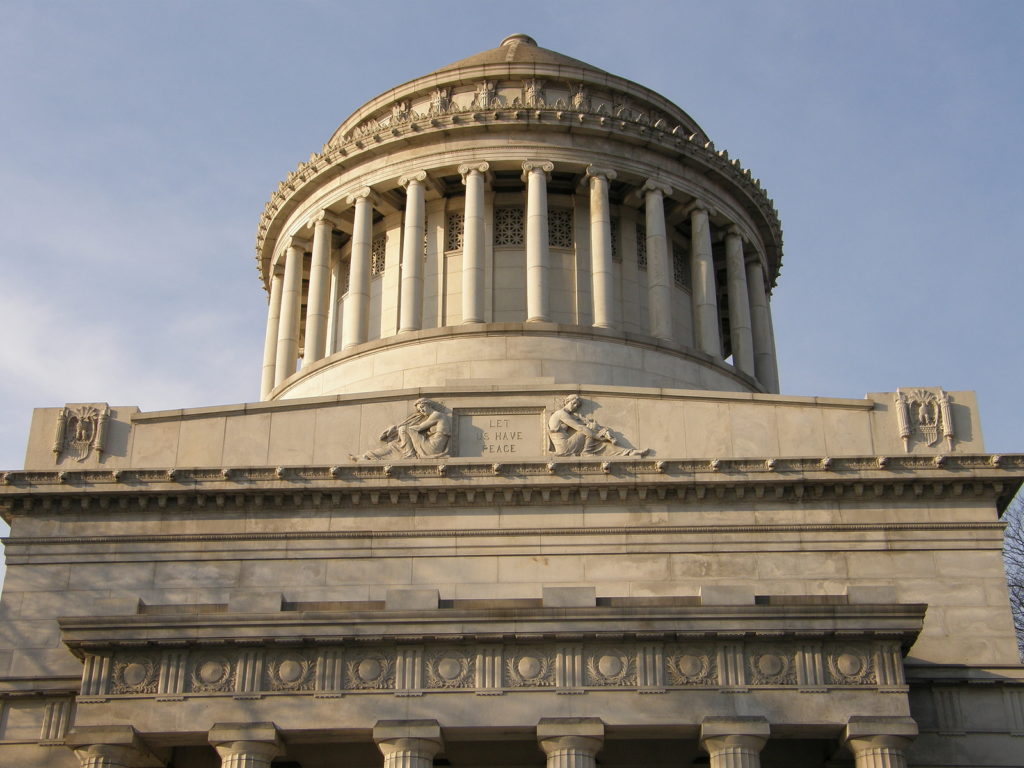
When it was originally opened, it was a big tourist destination. When we were there it was several years after 9/11, there was no one there. It was just the two of us and the ranger. It gives you that Ozymandias feeling. Here ‘look at my work and despair.’ here is somebody who was very important in his day and who’s pretty much forgotten now.
I know you’ve talked on your podcast about the tombs in New Orleans. And that comes out of the Père Lachaise the above-ground graves in Europe.
But in New Orleans, they’ve got the public tombs where a society will buy a huge mausoleum, and then anyone who belongs to that society can be buried there.
So, they’re all jumbled up together inside and I think that’s really neat that there’s no separation once people are dead. They’re all stored together in there. The architecture is the one aspect of cemeteries that I don’t know as well as I should.
Jo: I must say the New Orleans at St. Louis number one, which is the main one and you go on the tour and it really is an incredible place and it’s much smaller than I expected.
Loren: It’s tiny.
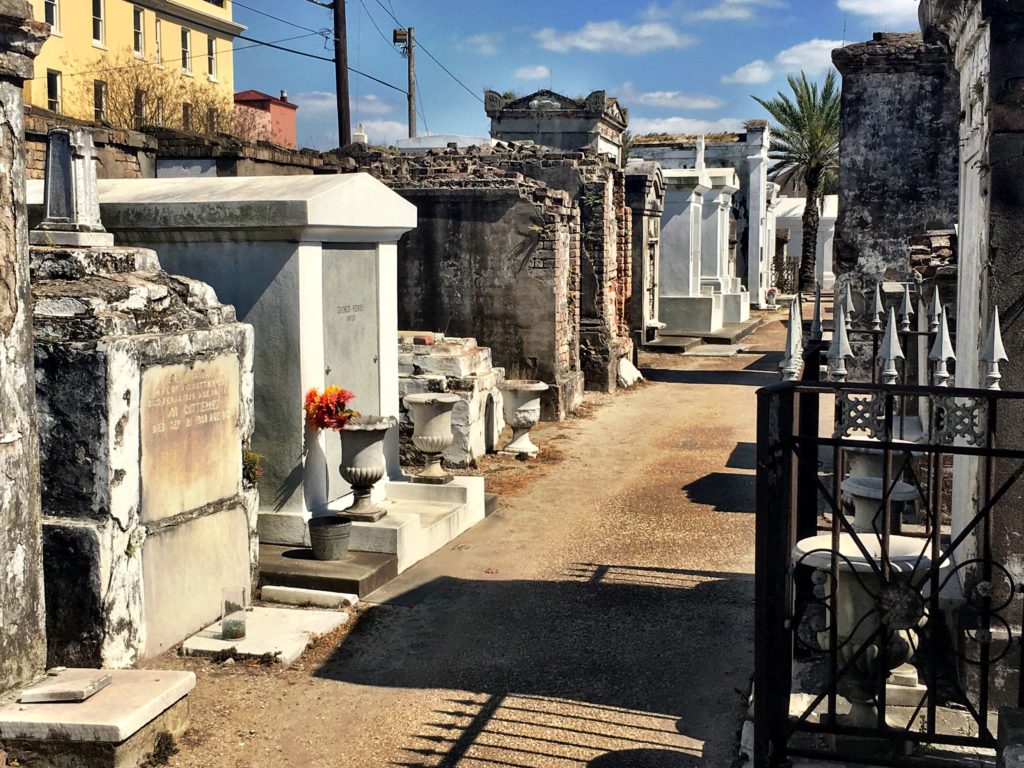
Jo: There are some bigger ones, they’re a bit further out but that one is tiny.
Just in case people don’t know, why build above-ground tombs?
Loren: It varies. Sometimes the ground is too rocky, that’s often the case in the Mediterranean countries. In New Orleans the water table is high and so there are graveyards where people are buried in the ground but it’s uncommon there. More tombs are built above ground so that you don’t have to contend with the water floating things back up.
Jo: Exactly. You mentioned with was it Grant’s mausoleum, whether it’s actually more dominant in a landscape whereas if you’re buried underground, I guess you could build some really big stone on top. If you have something tall and big, it’s a bigger marker.
Loren: The burying people in the ground and then raising something over them goes back to the barrows in England. Outside of Stonehenge, there’re all those barrow tombs where they’d put the king in there and then all his stuff, and then they’d raise a hill over it.
And there are graves like that in the U.S. too. Some of the, I think it’s the Edina people in Ohio, prehistoric to Westerners, but they raised these huge earth mountains. And it’s true out here in California as well where the people would raise a shell mound and bury their dead and build their village on top of it so that they could be there with their people.
The sense of marking graves and changing the landscape goes back to the Neanderthals. I think that’s really cool that we have this continuity that it’s important to us to know where our dead are buried.
Jo: What are some of your favorite burial grounds like that where the bodies are underground? People think of a churchyard, those bodies are usually underground.
Any beautiful ones spring to mind?
Loren: I went to the Old Jewish Cemetery in Prague years ago. And that one particularly struck me because the graveyard is in the heart of the ghetto. Jews were not allowed to be buried anywhere else, but that one little patch of land for centuries. This dates back to like the 1300s. So, they didn’t have any option but to bring in more dirt and raise the level of the graveyard, pull all the headstones up to the surface, bury the next level of people, bring in some more dirt, raise the headstones up again. And so the cemetery itself is seven layers deep.
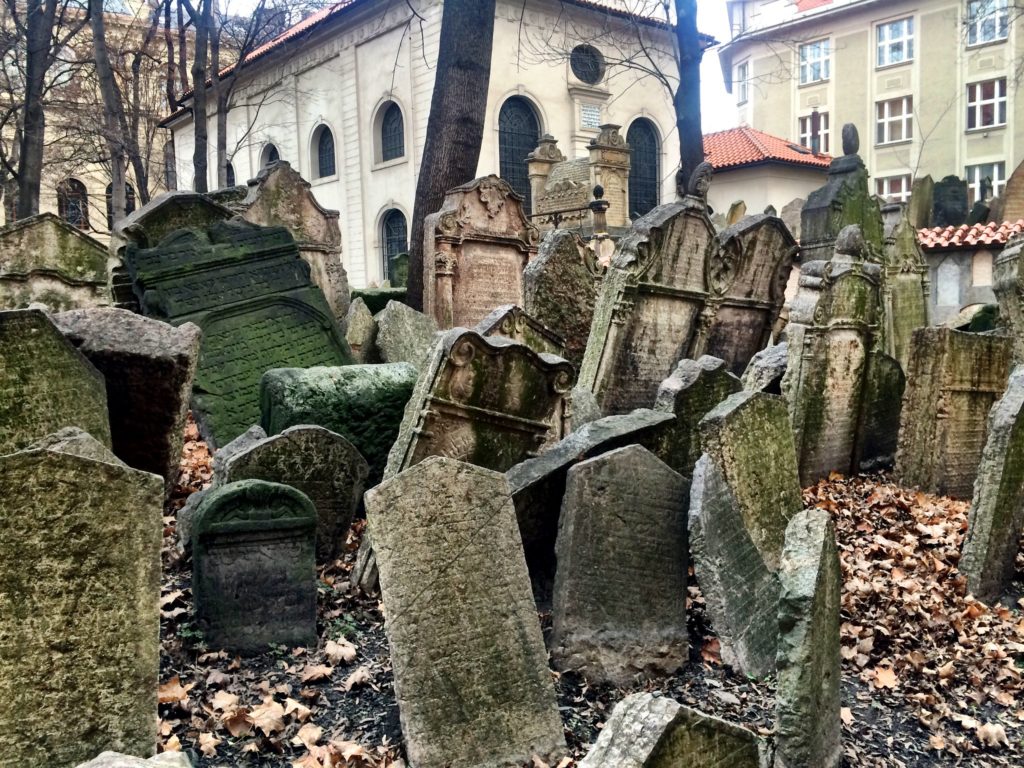
As you walk around it, the walls of the cemetery tower over your head because they’ve raised the level of the ground so many times. That to me is amazing that there are centuries of people buried together there and the cemetery itself is really beautiful.
I was there in the autumn and all the leaves were yellow and drifted up against these old gray and slightly pink stones. And the iconography was really pretty, there were pictures, and hands, and birds, and lions and things that you don’t often see in other graveyards beyond the Jewish faith.
Jo: That is a beautiful graveyard, I’ve also been there, and we went in the winter, we went for New Year and visited. And of course, I find the Hebrew language as well is just incredibly beautiful. We can’t read it, but the lines of the letters just feel just really pleasing.
And then of course there are the stones, Jewish people put stones on a grave in remembrance. So, you walk around and some of the grave there’s a famous rabbi buried there who there are always stones on his grave. You’re right, that one does stand out.
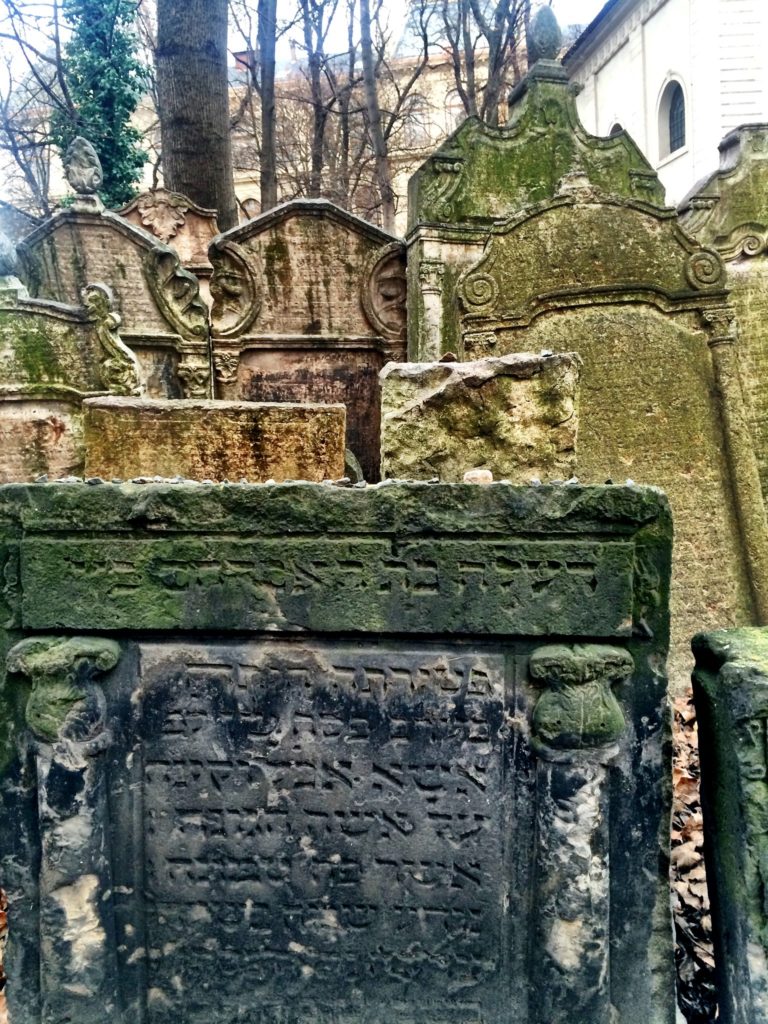
Loren: It’s so different than anything else.
Jo: What about any other places, the churchyards? Obviously, I’m in Europe and we have so many here but when I think of America, we’ve mentioned New Orleans.
Are there such elaborate graveyards in the U.S. as there are in Europe?
Loren: Oh yes. I felt like there were holes in my graveyard education. So, we went on a trip to the East Coast, rented a car, and drove around and I wanted to see the cemeteries that have been inspired by Père Lachaise.
First among those we had to see Mount Auburn which is in Cambridge outside of Boston in Massachusetts. And it’s spectacular. It was designed specifically to be a graveyard where nature would predominate. The graves are tucked in and they’re lovely. But the nature is the really eye-catching spectacular part.
There are lakes, and hills, and little dells and everything is designed to make you feel like you’re in the Garden of Eden. Heaven should be a lovely, beautiful place like this. And that was the first one we went to.
We drove up to Providence, Rhode Island and went to Swan Point Cemetery, which is probably the most beautiful cemetery I’ve ever seen. And I think it’s a factor of we were there in spring. Swan Point overlooks the river so it’s up on high ground. And it is full of these lovely old trees all of which were blooming when we were there.
There were just these spectacular weeping cherries and apple trees, and petals fluttering on the breeze as we walked around the graves and it was really, really beautiful. One of those moments where you were so glad to be alive in this place at this moment. I don’t know if you could get that feeling just walking around a park, maybe, maybe. But there’s a sense of being alive when so many people don’t have that luxury anymore. It was really remarkable, I think. Just spectacularly pretty.
Jo: I was thinking about in terms of in beautiful locations. I visited this very remote cemetery on the Shetland Islands with this stark ocean, the North Sea in front of it, and it just felt like wow, this really is the end of the earth.
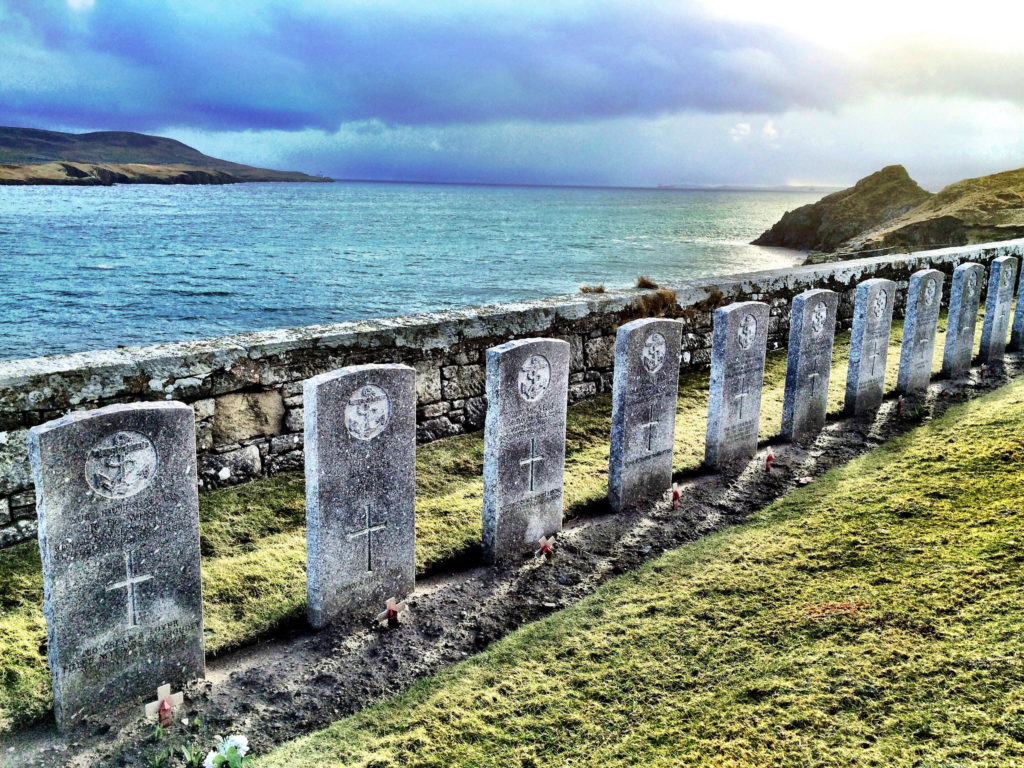
I was walking alone and there was an oncoming hailstorm. And it just felt so wild but so beautiful that this graveyard was on this prime landscape looking out to the ocean and the graves were looking out to the ocean and the text on the graves. Rather than, so you would almost have to stand, and they had the view rather than you which was fascinating.
Loren: The book I’m working on now is Beautiful Cemeteries Around the World specifically picking them for their beauty. There’s one in Monaco that faces the Mediterranean where Roger Moore is buried, a bunch of famous people are buried there, Le Mans drivers, all kinds of people.
The fact that, like you say, the graves are facing the water, they’re looking out at this spectacular view is so pretty. I love that about cemeteries.
One of the ones I’ve been to is in the heart of Yosemite Valley where you’re surrounded by all this grandeur and these towering trees and those enormous mountains and the waterfalls and all of that. In the very heart of it, there’s a cemetery where the original people who opened the first hotel in the valley, the original caretakers are, were gathered kind of from…when they originally died they were buried where they fell.
But at some point, all of their graves were gathered together into this tiny little cemetery, and what better place to be than the place that you loved, and you spent your life trying to protect and now you’re there eternally? That’s really cool.
Jo: It is. And then another thing that I think we have quite a few of in Europe is the catacombs and the ossuaries, which essentially, a lot of the times it was plague dead and there just weren’t enough places. So, they dug up the bones and in Paris, they arrange all the bones into interesting shapes.
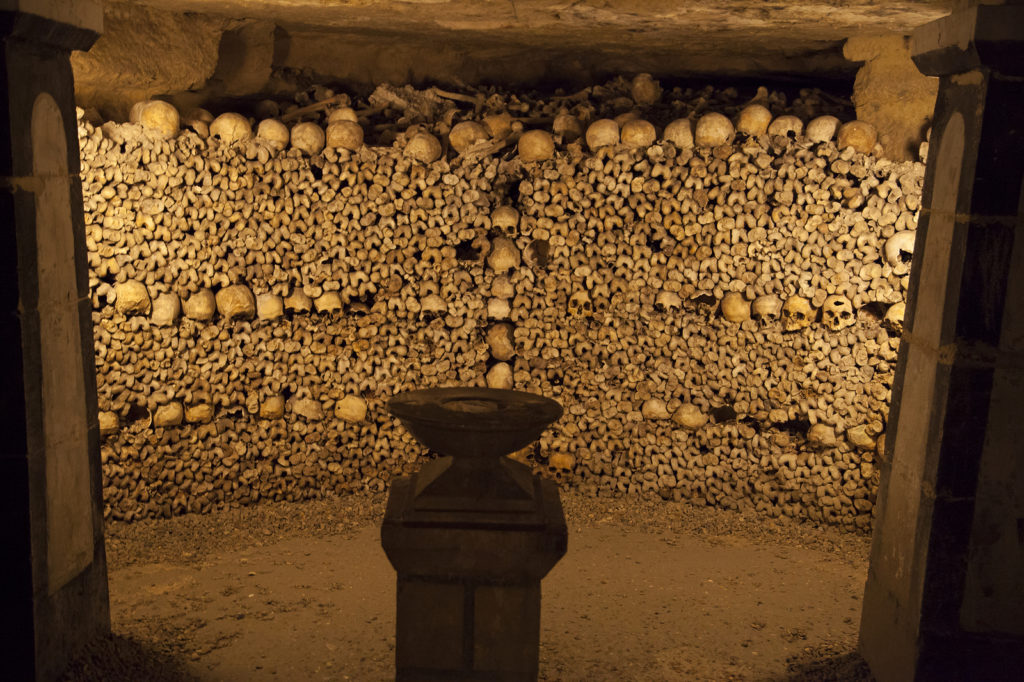
What are some of those catacombs or ossuaries that you particularly like?
Loren: The thing that fascinates me about the ossuaries is that originally in the Middle Ages, the belief was, you needed to have all your pieces on Judgement Day. When Gabriel sounded his horn you had to be able to pull yourself back together and walk before the throne of God and if you couldn’t find a piece that would be a problem.
So, they couldn’t part with anybody’s bones, right? They didn’t necessarily need to have them in the ground or even connected to each other. But they needed to save them all because people would need those. So, one of the most amazing places I’ve been is the Church of Immaculate Conception in Rome. Have you been there?
Jo: No, I don’t think so.
Loren: Oh my goodness, it’s not very big, it’s basically seven little chapels. But when the Capuchin monks moved from, they had a farm outside of the city, they moved into town, they dug up all their dead and brought them with them. And so, one of the monks was charged with arranging these bones in the chapels and making beautiful holy art out of that.
It’s kind of playful. They’ve taken the bones and they’ve made chandeliers and garlands and there’s a room where the ceiling has Death, which, that was easy. They just put a skeleton together but he’s holding a scythe made of bones and there are winged hourglasses that are made of bones, everything, all the artwork is made of bones.
It could be morbid. It could be scary or upsetting or whatever, but it’s not. The sense you get that this is really joyful, that they are looking forward to the time where they can pull these bones back together and go home.
I’ve been to a couple of catacombs but it’s one of those places where like you’re saying there aren’t anything, there isn’t anything like that here in the U.S. And so, I have to make that pilgrimage to see those.
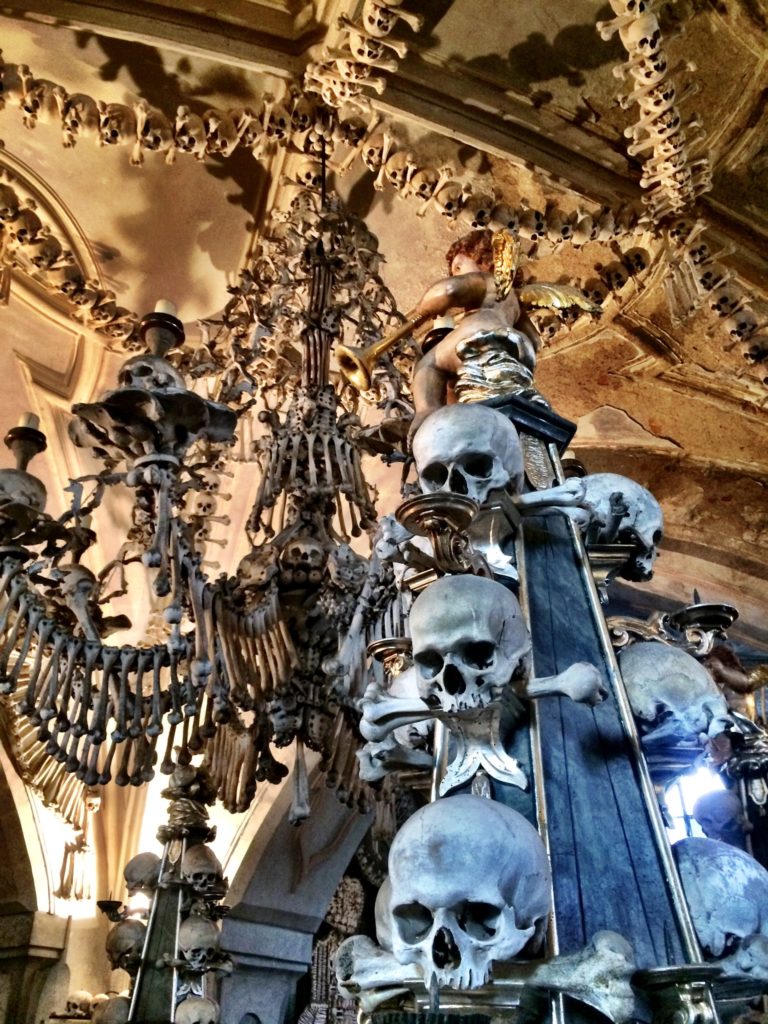
Jo: I think that sounds very much like Sedlec in the Czech Republic, just outside of Prague. The bone church there is similar with the chandeliers and these towering sculptures and it feels kind of abstract. As you said, it’s holy art. It doesn’t make you think of the dead.
Loren: I went there for my birthday.
Jo: We would so get on! That’s exactly the type of thing I do on my birthday.
Loren: We were in Prague, which I knew I’ve heard about my whole life, but it seemed just impossibly foreign and difficult to get to. And my husband said, ‘What do you want to do for your birthday?’ And I said, ‘I’d really like to go to Kutná Hora and see the ossuary.’ So, that’s what we did.
It turned out to be kind of an epic journey because we couldn’t read the train schedules and ended up on a local. So, it was a longer trip than we intended, but it was so worth it. The place is not very big, but it’s got 40,000 people buried in it. And just mounds of skulls and there’s a coat of arms formed with bones, do you remember that, where you see the bird pecking, the bird is made of bones and it’s pecking a skull and just amazing.
You think how did they do this? Did they spread them all out? So you had all the vertebrae together and all those skulls in one pile and then they decide, ‘Well, I need to have this piece, let me take that block and put it here.’ Or did they just grab what was to hand and say, ‘Okay, what can we make with this?’ Amazing, amazing stuff.
Jo: It is. And what do you think? I feel like a lot of Americans think it’s quite weird to have these ossuaries and these catacombs rooms full of bones because it’s not something that you have in North America. Is it literally because there just aren’t these big mass graves where they didn’t do it historically? Do you think that style has gone out of fashion as such?
Loren: Here in America, most places, they don’t have much respect for the dead, I guess is the way I want to to say it. I live in San Francisco, and there aren’t any active graveyards here. They moved them all out. The last of them was kicked out in the ’40s. And they pretty much, it took them 40 years, the city fathers decided we’re on a peninsula, we’re bounded by water on three sides, and the cemeteries have prime land. So, they’d much rather build houses there.
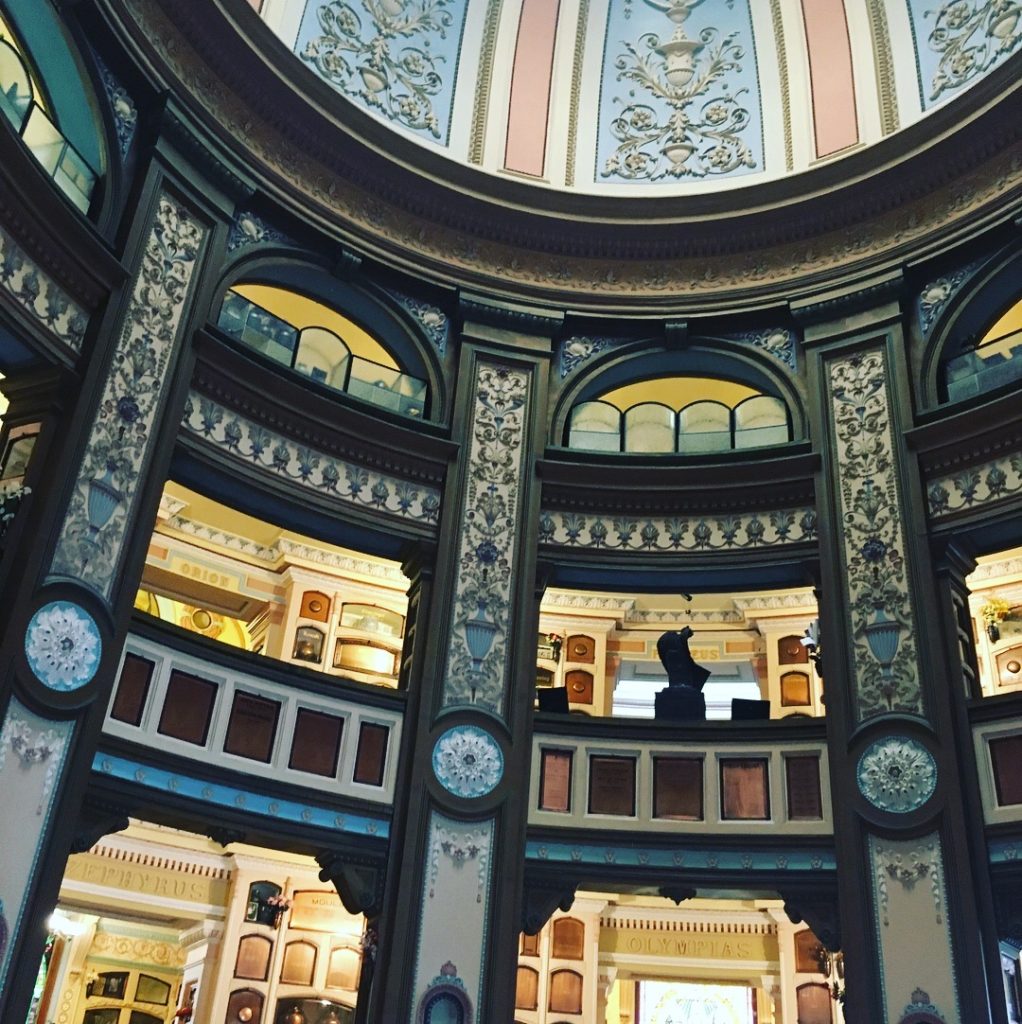
It took years to talk the people in San Francisco into saying, ‘Okay, yes, dig the graves up.’ But they pretty much dug up anybody whose family hadn’t picked them up and moved them and put them in mass graves. One of them is a field that’s surrounded by a chain-link fence, there are 20,000 people buried there, but you can’t visit it. There’s no indication of who those people were. And some of the people that are in these mass graves were the founding fathers of the city.
In Cypress Lawn, their mass grave has a little more respect to it. But Andrew Holliday, who is the man who designed the cable cars, which San Francisco is known for, he is buried in a mass grave. Anywhere else in the world, this guy would have some respect but not in the U.S.
So, I think that’s some of it is that for a lot of places in the U.S., the data of inconvenience and so, once families aren’t there, taking care of the graves and advocating for their dead, the city feels thoroughly justified in just plowing over them or in some cases, not even moving the bodies but just building on top of them.
Jo: It’s fascinating. My will says cremate me because one, there’s a financial aspect of having a grave plot and a full-on headstone. And people might not realize that often you have to pay for the years. It’s not, like, just buy it and you’ve got it for the end of time. And I feel like maybe the cultural attitude to death as you say, it is very different.
The use of the physical body in art, which is what we’re just talking about there with the ossuaries, it’s just something that does not fit with a modern idea of what death is.
Loren: There are a number of places now that will take cremains and make art out of them. And so, it’s sort of the same thing.
My cat passed on, and he was my muse. So, I’ve had his ashes on my desk for, I don’t know, 10 years now. Because I can’t seem to part with him. But I found a place that will make paperweights out of cremated remains. And so, I have this beautiful piece of artwork where I can remember him.
It’s not the same as having a mobile or whatever made out of his bones, but people don’t look at me twice when I have this paperweight on my desk. I think you’re right. I think the sensibility is changing. We’re faced with the reality now that people don’t stay in the same community for generations the way they used to. And so, why would you have a grave in a place where your family doesn’t live anymore?
We’re sort of on a, I don’t know, precipice is not the word I want. But we’re at a moment where things are changing, and maybe even more with this pandemic, where we’re seeing the fragility of not only life but of eternity. That who will be here to remember us?
Jo: Even if you have children, grandchildren, great-grandchildren, I don’t know who my great grandparents were. Some people do, and there are some religious traditions particularly that trace all those things back. But it really is about what can you do in your lifetime, and it is fascinating.
The other thing I think’s interesting right now is that even if you get cremated, there are all these different levels of you can have the really expensive coffin with all the brass bits. Or you can go with a wicker basket with flowers or you can get a natural burial.
I talk about it with my mom, she’s very open to talking about these things. And we have a laugh about it and talk about that.
I almost feel things are going the other way, that there is a rejection of some of the overly fake death rituals and going back to a more natural style.
Loren: One of the cemeteries that’s in 199 Cemeteries is an underwater cemetery. Where you can have your cremated remains mixed into cement and then they make art out of them and they sink them to the floor of the ocean. And then corals grow on it or fish come around and it’s taking that sense of permanency and memory-keeping but making beauty out of it and allowing nature to, I don’t know, colonize it maybe.
Jo: Life continues.
Loren: Exactly. And I know there are some similar things in the UK where they’re making these pyramids and dropping them into the water. I want to say Solace Reef, where they’re designed for lobsters to come and the little lobsters can live in the crevices of the rock until they’re big enough to be safe in the open ocean. And I just find that idea really beautiful that somehow by my death I can help the planet. I think there’s something life-affirming about that.
Jo: There is, and then I was also thinking and then we catch the lobster and eat it for dinner and thus it’s the circle of life!
Loren: Right, right.
Jo: I love that. And in fact, just talking about food, we actually went for a walk the other day around a local cemetery and, it’s not so common in Britain, but there was a family having their lunch at the grave with lots of flowers.
You see it much more commonly, I think in, where I’ve been in the Pacific Islands for example, or in Mexico. I think also on Day of the Dead or whatever, you go and visit the ancestors and you eat at the graveside and it’s almost like you’re inviting them to the party.
That’s not in my culture, as an English person, but I find that interesting.
Loren: It used to be, 100 years ago that was very common to take a picnic and go sit in the cemetery. Maybe not 100 years, let’s say 150 years. Because prior to that there weren’t any city parks. Only rich people could afford land that was natural. Everybody else lived crowded into cities and there weren’t parks or trees or greenery, anything like that.
So, if you needed to escape, you went to the cemetery. And people would picnic and court and read books and do what we’re doing now, reclaiming it and appreciating life a little bit. In the intervening years, that’s fallen out of fashion, and now people think it’s unusual, but not that long ago, it was common. I love the idea of having a cemetery picnic and asking the ghosts to come along.
Jo: Do you feel a supernatural and or spiritual aspect, something that is not physical, when you visit a graveyard? Or have you had any experiences like that?
Or is it truly the most physical place where physical bodies go back to the earth?
Loren: I had an experience. There’s a cemetery across the Bay in Oakland, California that’s beautiful. It’s built on a hillside. It overlooks the water in San Francisco and the distance. And some of the wealthy families of San Francisco and the Bay Area have these amazing family tombs up on a hill.
A friend of mine organized this little ghost hunting tour. There were seven of us and we started, it was sunset, roaming around in there with a guide from the cemetery. And as we walked through the potter’s field, we discovered a gravestone and the guide said, ‘Oh, I had no idea there were stones here.’
It’s a potter’s field. Often those graves aren’t marked at all, but we kind of dug it out and I got this strange feeling, the back of my neck got really cold and I got a crick in it. I thought, ‘Jeez, this is weird.’ It was warm that evening, and still, there wasn’t a breath of wind. And one of the women came over and said, ‘You’re standing funny, what’s going on?’
And I said, ‘I don’t know, my neck really hurts.’ And one of the other women was a psychic. She came over and she said, ‘Oh, the woman that is buried here was a servant, and she fell or was pushed or somehow was induced to throw herself down the stairs. She broke her neck and she was pregnant with the son of the family she worked for, his child.’
I don’t know that that was a ghostly experience, but it was, wow, I can’t even talk about it now. It was a really strange sensation that I was so happy to move away from that, just that one moment where we discovered her stone, we didn’t even know she was there. And then suddenly there was this whole story that unfolded from her.
I don’t know if that was ghostly or just a weird coincidence, or whether the psychic took my discomfort and the name and spun a story out of it or not. But I’d like to believe in ghosts. I don’t really require any evidence because I’d like to feel like we can continue, that death isn’t the absolute end. Don’t know.
I haven’t had as many experiences as I’ve been to graveyards, I’ve been to a lot of graveyards. But something happens and you’re just like, I have no logical explanation for this.
Jo: I really haven’t had anything like that, even though I’ve been on ghost tours and I’ve been on these things at night Edinburgh, ghost walks and things like that. I have had experiences where I feel more awe and wonder where I feel almost transcendence.
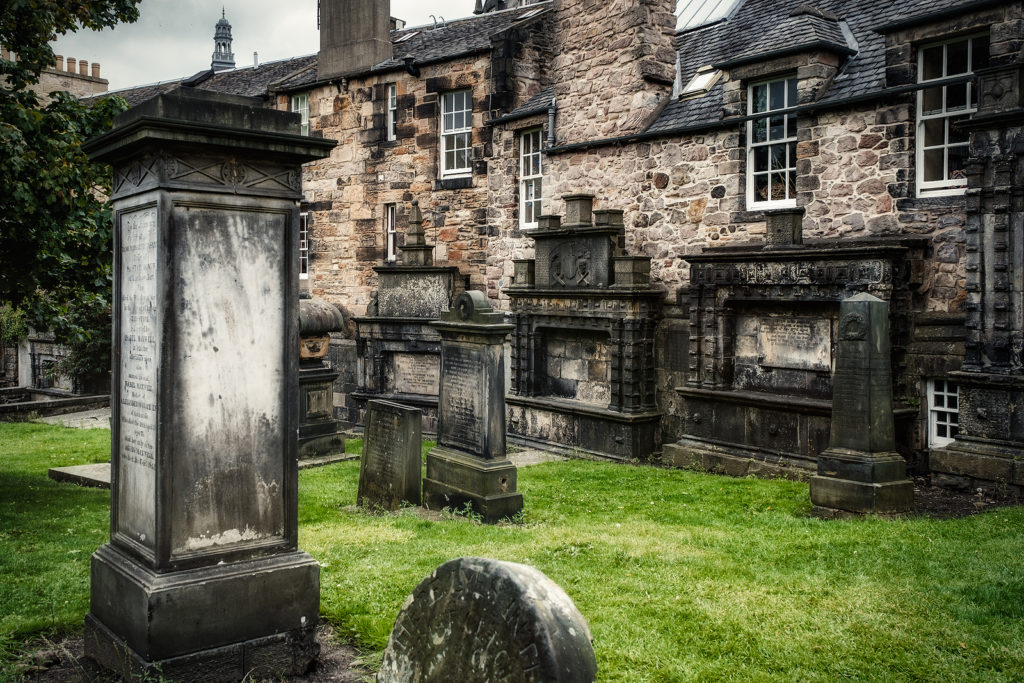
I’m not a Christian but if that’s God or Spirit or whatever people want to call it, but that sense of the world is bigger than just me, which I find liberating. I feel that feeling is a good feeling. I think that does come back to the memento mori as we started, with realizing this is life and that’s fantastic.
We are almost out of time. I mean, we could talk about this all day.
Loren: Time went really fast.
Jo: I know. I absolutely love your books, 199 Cemeteries to See Before You Die and Wish You Were Here, particularly. I know you’ve got some more coming out.
What are some other books that you would recommend about cemeteries or set in cemeteries or places of death?
Loren: One of the best ones, as an overview of cemetery history is The American Resting Place by Marilyn Yalom. It is focused on America, but it starts with the native history and goes through all the different ways of styles of cemeteries. And it’s just really readable and easy to understand.
Let’s see. I made a list because I knew I would never remember all these. Stories in Stone, a field Guide to Cemetery, Symbolism and Iconography by Douglas Keester is probably the best book that illustrates what you’re looking at when you see a gravestone. What do three links of a chain mean or the all-seeing eye of God? Or what do the images that you see mean? And that is worldwide. He is one of the most traveled cemetery historians. And it’s beautifully illustrated, full of color pictures.
I just read Necropolis: London and It’s Dead by Catharine Arnold. I don’t know if you’ve read that book.
Jo: Yes, I have. That’s a great book.
Loren: She is so good at making all the history of London come alive. It’s so rich compared to San Francisco was founded in 1776. So, it’s really not that old compared to London. The Empire of Death: A Cultural History of Ossuaries and Charnel Houses by Paul Koudounaris is spectacularly beautiful.
Jo: I love all his books, they’re amazing.
Loren: And it makes it seem less creepy. He has such a gift of taking these things that from a Western point, from a modernist point, they seem weird, these death rituals and he makes them perfectly understandable. And he has a gift for making you really feel connected to the people in the past.
The last one I wanted to mention is a brand new one that came out last year, Sacred Ground, The Cemeteries of New Orleans by Robert Brentley. Instead of standing at the grave and saying, ‘Oh, this kind of stone, and it’s got this kind of iconography,’ he got curious about the people buried there.
It’s pretty much the story of one man’s curiosity as he roamed around the cemeteries of New Orleans and poked into who these people were and why they’re remembered. And some of them are famous people, but many of them are not. And the stories he comes up with are really wonderful. So yeah. That’s five, it was hard for me to pick five because I’ve read hundreds.
Jo: Yes. And you actually have lots of extra reading and things on your website.
Why don’t you tell people where they can find you and everything you do online?
Loren: My cemetery website is CemeteryTravel.com and, it’s the record of my fixation. I talk about cemeteries that I’ve visited, I post photographs from people who been to cemeteries that I haven’t been able to see yet. And starting now, it’s going to be research for the new cemetery book I’m working on The World’s Most Beautiful Cemeteries.
Jo: I will look forward to that book. And thank you so much for your time, Loren. That was great.
Loren: Thank you so much for having me. When you wrote and said you had, you were a taphophile, I was, ‘Great, somebody who totally understands this, I can talk about anything.’ I think it’s getting more common and fewer people are freaked out about it, but every now and then I meet somebody who is, like, ‘You spend your vacations in cemeteries?’ ‘Oh yeah. I think everybody ought to.’
Jo: Exactly.



Leave a Reply